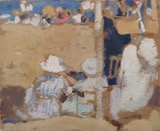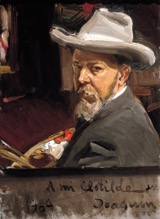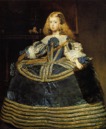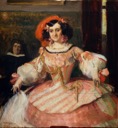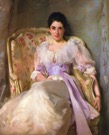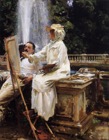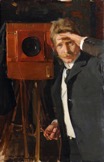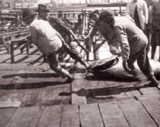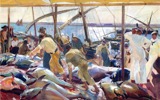The basis of Sorolla's faultless technique was the drawings skills that he had learnt in his childhood.
Sorolla, 1881
But he was not a slave to technique – truth and sincerity were his key objectives, and these came from observation and hard work.
Sorolla painted very, very fast. "I could not paint at all if I had to paint slowly," he once said. "Every effect is so transient, it must be rapidly painted."
Besides Sundays, he would work six to nine hours a day, often standing in the full glare of the sun dressed in a suit. Most of his pictures were painted in from four to six mornings, many in one or two.
Making of: The Horse's Bath. 1909

Making of: Children on the Beach. 1916
Sorolla did not have a set idea of how a painting would turn out before he started, preferring to build up the composition as he went along.
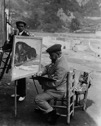
Joaquin Sorolla in action
Palette
In terms of colour, from about 1900 onwards for outdoor work (as opposed to studio portraits), Sorolla dropped the “earth pigments” (umbers, etc) so his palette consisted of cobalt violet, rose madder, all the cadmium reds, cadmium orange, all the cadmium yellows, yellow ochre, chrome green, viridian, Prussian blue, cobalt blue, French ultramarine and lead white.
For studio portraits, he changed his palette entirely to one that included black, burnt umber, raw umber, rose madder, burnt sienna, raw sienna, yellow ochre, Naples yellow, vermilion and cobalt blue. Occasionally he would add orange, pink or purple, but he usually emphasized strong tonal contrasts over ambitious colour effects. [source: Charles Sovek Light & Colour Sorolla Style]
In the studio Sorolla would sometimes use a palette the size of a grand piano lid and 3 foot long brushes to allow him to stand back from his painting.
Joaquin Sorolla’s Self-portrait, 1909
Quotes
"I could not paint at all if I had to paint slowly. Every effect is so transient, it must be rapidly painted.”
"The great difficulty with large canvases is that they should by right be painted as fast as a sketch. By speed only can you gain an appearance of fleeting effect. But to paint a three yard canvas with the same dispatch as one of ten inches is well-nigh impossible.”
"If ever a painter wrought a miracle of illusion with brush and pigment that painter was Velazquez in his 'Las Meninas,' at the Prado in Madrid. Now, I have studied this picture with a lens, and what do I find? Why, that Velazquez got that marvelous atmospheric background by one broad sweep of his flowing brush, charged with thin color so thin that you can feel the very texture of the canvas through it. Nature, the sun itself, produces color effects on this same principle, but instantaneously. The impression of these evanescent visions is what we make desperate attempts to catch and fix by any means at hand. At such moments I am unconscious of materials, of style, of rules, of everything that intervenes between my perception and the object or idea perceived. No, mes amis, impressionism is not charlatanry, nor a formula, nor a school. I should say rather it is the bold resolve to throw all those things overboard."
"I hate darkness. Claude Monet once said that painting in general did not have light enough in it. I agree with him. We painters, however, can never reproduce sunlight as it really is. I can only approach the truth of it.”
"With all its excesses, the modern impressionistic movement has given us one discovery, the color violet. It is the only discovery of importance in the art world since Velazquez."
"When an artist begins to count strokes instead of regarding nature he is lost. This preoccupation with technique, at the expense of truth and sincerity, is the principal fault I find in much of the work of modern painters."
“Go to nature with no parti pris. You should not know what your picture is to look like until it is done. Just see the picture that is coming."
"The older I become, the more I realize that drawing is the most important of all the problems of picture-making."
"As far as outdoor work is concerned, a studio is only a garage; a place in which to store pictures and repair them, never a place in which to paint them."
"I do not care to paint portraits indoors. I cannot feel sympathetic."
Diego Velazquez (1599-1660)
Influences: Artists
Diego Velazquez
Joaquin Sorolla
Infanta Margarita Teresa in a Blue Dress, 1660
The Actress María Guerrero as 'La Dama Boba', 1901
John Singer Sargent (1856-1925)
John Singer Sargent
Joaquin Sorolla
Lady Agnew 1893
Clotilde sitting on the sofa, 1910
The Fountain, Villa Torlonia, Frascati, Italy, 1907
Anders Zorn (1860 - 1920)
Anders Zorn
Joaquin Sorolla
Portrait of Franz Heiss, 1902
Portrait of Gordon Stevenson, 1917
Portrait of Franz Heiss, 1902
Influences: Photography
Portrait of Franzen the photographer
As an artist myself, I am fascinated by the techniques that Sorolla employed and have loved looking at his palette, paints and brushes in the Museo Sorolla.
One of the questions that often goes through my mind is whether Sorolla used reference photos as an aide to his studio paintings (which is what I do).
Sorolla was certainly no luddite when it came to photography - in his teens he worked as an assistant in the photographic studio of Antonio García Peris, whose daughter Sorolla would later marry.
Clotilde seemingly holding a camera in this painting from a Biarritz series
In my researches I was particularly interested in an article posted to the “taotothethruth” blog (http://taotothetruth.blogspot.fr/2011_01_01_archive.html), from which I have taken the following quotes showing that the debate started a long time ago -
'It has been said that Sorolla made free use of photographs in his canvases depicting action. Although he showed me many snapshots of beach scenes, I never saw him use them while painting.” Gordon Stevenson (student of Sorolla)
'Sorolla's works are mere chromolithographs, his paintings of children racing on the beach are but copies of instantaneous photographs' ~ New York Evening Post of 12 June 1909
“It has often been assumed that Sorolla's success in capturing light and movement was aided by referring to photographs, as Sargent is said to have reported.” (see- The World, 14 Feb. 1926)
'I have always remembered with amusement what happened when I went with Boldini to the Sorolla exhibition at the Georges Petit Gallery in Paris. As we progressed from picture to picture Boldini seemed suddenly to get into the grip of some hidden excitement and for a time hesitated about telling me just what was the matter. At last he could stand it no longer. "This man must work with a camera", he said. "They look like so many snapshots." Royal Cortissoz in Scribner's (May 1926)
And this photo on the above blog and the comparison with The Tuna Catch certainly made me think -
Ayamonte, The Tuna Catch, 1919



